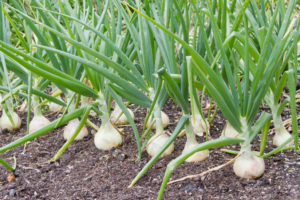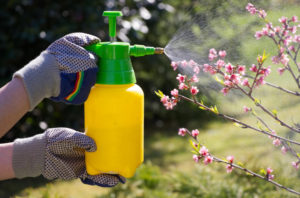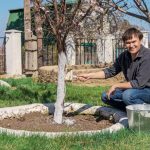Don’t frown and shrug it off when it comes to plant protection. Of course, in the view of many, this is a constant abundant spraying of the garden with pesticides. But in fact, the protection of plants from diseases and pests is a whole science, based primarily on agrotechnical measures, i.e. the creation of conditions under which plants normally grow and develop.
The use of pesticides to reduce the number of harmful organisms (pests) and the spread of pathogens (bacteria, fungi, viruses) is the last resort.
How can proper agricultural techniques protect plants?
Selection of a plot for planting tree species or ornamental shrubs; compliance with soil indicators; drainage or, conversely, additional watering; illumination; use of zoned varieties or species; quality of planting material; timely fertilizing; thinning; pruning of individual dry branches; removal of dead plants; weed control — all these are agrotechnical measures.

For example, your pines will not grow on peatlands. Most plants do not grow well on sandy soils, where they lack nutrients. Roses and lilies require a lot of sun, and shade-loving plants die in bright light. Apricots are bad in the middle lane. Sea buckthorn suffers from frequent winter thaws, and coniferous trees with a strong thickening of landings or improper watering dry up strongly. If you add a strong overgrowth of our flower beds and Alpine hills with weeds, the picture of plant life is very sad, and this is all without taking into account the numerous hungry pests and a huge number of different diseases.
Do not think that if you gave up fruit crops, you immediately got rid of diseases and pests. Many ornamental plants belong to the same families and genera as fruit plants, and are consequently affected by the same diseases and damaged by the same pests.
Pests: what are they?
Pests are divided into draining that feed on the juice of young leaves and green shoots, and gnawing, roughly eating leaves, shoots, buds, stems, bulbs, and even the roots of plants.

To draining include:
- Aphidoidea,
- Thysanoptera,
- Diaspididae,
- Pseudococcidae,
- Acari,
- Heteroptera,
- Cicadellidae.
Symptoms of damage by these pests are manifested in the form of changes in color, drying of leaves and branches. The damage can be identified and the main gnawing pests:

- many butterfly caterpillars and larvae, as well as beetles, eat the budding buds, leaves and needles during additional feeding;
- the caterpillars of Malacosoma neustria and Chrysopidae eat the buds and bark of shoots;
- Chrysomelidae and their larvae skeletonize leaves;
- Anthonomus pomorum damages the buds;
- Byctiscus betuleti F. curl leaves;
- Cameraria ohridella, some sawflies cause the formation of mines on the leaves;
- many aphidoidea Form galls;
- Scolytinae, Cerambycidae, Curculionidae, Buprestidae larvae burrow under the bark, in the wood and inside the shoots;
- some Curculionidae, Tortricidae caterpillars, and Pyralidae eat fruits and seeds.
How and where do pests live
A characteristic feature of pests is that almost all of them are very small, and there are a lot of them. In addition to keeping the population under the influence of the environment, under threat from natural enemies, several generations of pests can develop in a season. Many insects have a special protective color to match the color of forage plants. Bedbugs secrete a special liquid with a repellent smell.

Some pests feed on one plant species and are monophages, others feed and develop on several and are called polyphages. So Pyrrhalta viburni is found only on viburnum, and Acari damage plants from different families.
Mass development of insects occurs during the warmest time of the year – July. Summer heat and sun bring us back to life. And not only us, but all living organisms around us. Almost all overwintered adult insects need additional nutrition and only then begin to lay eggs. And if the butterflies feed on the nectar of flowering plants, the beetles gnaw the buds, buds, young leaves. In mid-summer, insects can be found everywhere, since their development depends on vegetation, i.e. the development of plants.
Each pest has its own characteristics, its own cycle of development, its own food plants, but they all feed on our plants. Some lead a solitary lifestyle, while others live in large colonies. Females of the majority of representatives lay eggs in groups, ovipositors, pods, and all hatched larvae of younger age feed at first together and only after a few molts, spread along the branches.

Everything is balanced in nature. Plants develop insects, mites or mollusks, and they, in turn, are the main food for birds. There are also predatory insects that feed on others.
But you can not rely only on the help of natural enemies, they also have their own problems in life. And if the number of pests that eat our plants is initially insignificant, individual, then over the years the population gradually increases, and at one point you suddenly notice that the buds on the Apple tree do not open because of Anthonomus pomorum, the leaves on currant, cherry and viburnum are eaten by Tenthredinidae, Crataegus is all Coccidae, peonies, irises, gladioli, etc. Thysanoptera is damaged, and roses, spirea, cedars, and all the trees around are covered with Aphidoidea, and their sweet secretions are dripping from the leaves, as Aphidoidea has eaten too much.
So who was the garden created for?
At this moment, sitting in their eco-friendly garden, many people think: and for whom, in fact, did they create this garden? What kind of decorativeness is there, if the shoots are deformed, the buds do not open, the plants do not bloom, the leaves are all eaten, and instead of bushes there are bare branches… But the problem is not only in the loss of decorativeness — with a large number of pests, plants can completely dry up.

So the question arises: what should we do with all this? Some give up, others start looking for a way out. But without the use of insecticides in this situation, you can not do, because the life of plants is under threat.
Each garden has its own characteristics. But now you have identified your enemies and decisively went to a specialty store for a drug to destroy them. And the store offers so many things that the eyes run away.
Calm down, you have an ornamental garden with tree species, ornamental shrubs and flower crops. Most insecticides target Leptinotarsa decemlineata on potatoes that you don’t grow.
Rules for the use of insecticides and safety precautions
Be sure to take the instructions for use and read it carefully. No matter what drug you buy, the rules of use are the same for everyone and must always be observed: the concentration of the working solution, the multiplicity of treatments, waiting times for fruit and berry crops.
Almost all plants are allowed to be sprayed before and after flowering and, if necessary, additionally at the end of the growing season. For decorative berry crops, the last treatment should be 20-30 days before eating berries or fruits. Flowering plants are not allowed to be sprayed, as pollinating insects may die. And during pest control, please do not forget about personal safety measures.






